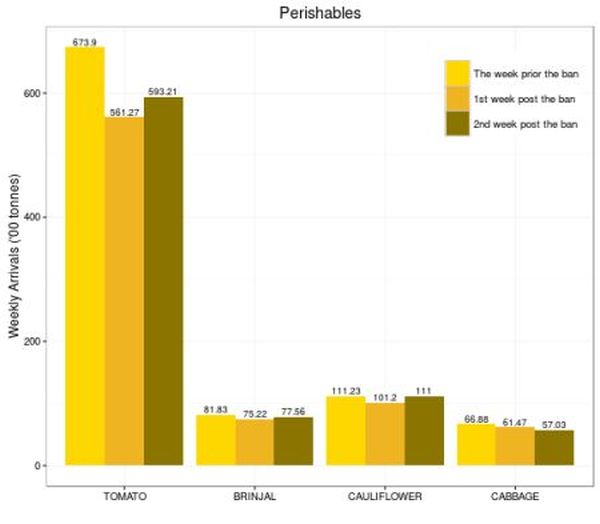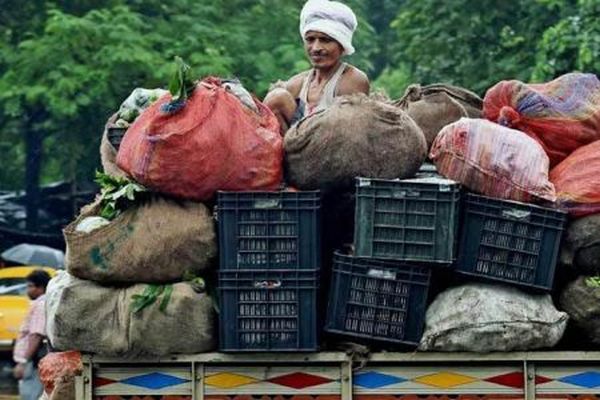In this article, Aggarwal and Narayanan contend that demonetisation alone cannot turn agricultural markets cashless. Such a shift would require sustained and focussed effort to expand the reach of formal institutions, especially for credit and storage.
It is now official. Demonetisation has led to an implosion of agricultural trade in the country. In the week following demonetisation, soybean arrivals in select major states had collapsed by 87% relative to average arrivals over the week preceding demonetisation. The figures were 55% for paddy, 61% for guar (cluster bean), 51% for maize, 38% for tur (pigeon pea), and 23% for cotton. Last year, for a comparable span, such effects are largely absent. As one would expect, these effects are muted for perishable commodities. Cabbage, cauliflower, tomato, and brinjal arrivals have fallen by 9% to 19%. Farmers with commodities that perish are more likely to offload their produce at deeply discounted prices or on credit, as long as the net benefits of doing so are higher than letting produce rot on farms.
Our research1 suggests that by the end of the second week, there are few signs of recovery. Paddy arrivals over the second week after demonetisation were 61% lower than in the week preceding demonetisation, comparable to the fall in the first week. For commodities such as soybean and maize, the arrivals were lower by 76.52% and 28.85% respectively. The decline, even though lower than in the first week following demonetisation, cannot be interpreted as a sign of recovery for two reasons. First, farmers, who cannot afford to store the produce any longer, have no choice but to bring the produce to the mandi2 and sell at either lower prices or on credit. The higher arrivals in the second week relative to the first week could, in part, reflect this. Second, for the actual recovery, reduced arrivals in the first week should show up as higher arrivals in the second week for the markets to get back on track. We do not see this trend yet in the data. This suggests perhaps that the concessions to farmers and traders at the agricultural produce market committees are yet to find traction. The impact on prices at the mandis is as yet unclear, although reports suggest dampening consumer prices. Another striking feature is the significant variation in the impact across states. For example, aggregated soybean and maize arrivals across mandis in Madhya Pradesh fell by about 97%. In contrast, aggregated soyabean arrivals in Maharashtra fell by 68%. Our hypothesis is that mandis that trade mostly in cash or have limited penetration of banks and are relatively less connected to urban areas are likely to be more affected. It is possible that transitions to bank payments reported in several states will expedite the recovery process, but only time will tell.
Figure 1. Weekly arrivals of non-perishables before and after demonetisation



While it is clear that this implosion of agricultural trade domestically will impact farmers adversely, some argue that this move can help the transition to a cashless economy. However, demonetisation in itself is unlikely to catalyse this shift. Here’s why.
Dependence on cash
There have been several reports already explaining why demonetisation might have hit farmers severely (see here, here and here). All of these emphasise the predominance of cash transactions in agricultural output markets. A counter viewpoint suggests a large number of farmers do routinely accept cheque payments and leverage warehouses to store and hold out for better prices. While the latter claim holds for specific commodities whose marketing is highly organised and institutionalised into cooperatives or procurement agencies like sugarcane, milk and cash crops like areca nut, this does not reflect Indian agriculture at large.
Furthermore, recorded mandi arrivals themselves tell only a part of the story. The mandi is sometimes not the most important marketing channel. For crops such as urad (black lentil), ragi (finger millet), jute and, coconut, for example, as much as 60-85% of reported agency-wise transactions constitutes sales to local private traders. Virtually all of these are cash transactions. It is conceivable that farmers are selling as much or more to these other players on credit consequent to demonetisation and perhaps even delivering against previous loans in the process. For kharif (monsoon crop) cotton and groundnut, likewise, input dealers are important buyers.
Even when payments are by cheque, one major constraint is the thin spread of bank branches. According to the report of the Committee on Medium-term Path on Financial Inclusion, in June 2015, the number of branches per 100,000 of population in rural and semi-urban areas in India was just 7.8 – less than half the number in the urban and metropolitan areas (18.7). The median global value as per the data from the World Bank in 2014 was 13.46.
Business correspondent models have had a variable track record. Studies point out, among other things, that these agents are more effective in reaching customers in larger clusters than those in smaller or scattered populations. Research also shows that most households tend to withdraw deposits fully, leaving their accounts dormant otherwise, and this is typically to extinguish informal debts that carry high interest rates. The engagement with banks has therefore been somewhat limited.
An aggravating factor in this crisis is the order restricting farmer access to primary agricultural cooperatives (PACs) to obtain liquidity post-demonetisation, when in many states, PACs are the dominant source of loans and are far more accessible to farmers than commercial bank branches.
Will demonetisation spur a cashless economy?
Recent field visits to mandis across Karnataka, where much effort has been made to transition to bank payments, suggest that farmers might not be uniformly enthusiastic about direct payments into their bank accounts for mandi transactions. In general, while some farmers, especially those who were members of cooperatives and were closer to urban centres, conceded that they would prefer this mode of payment, others indicated that going to a bank is a cumbersome and costly process. Online payments through banks take between 24-48 hours. Some also mentioned that bank officials do not treat them well and they prefer immediate cash payment by commission agents. Commission agents “treat us like partners”, said one farmer in Vijayapura. Others were worried that payments into their bank account would automatically serve to extinguish their loans and would be unavailable to them as cash.
The fact remains that a large chunk of India’s farmers continue to depend on commission agents for credit, consumption loans, information, and storage facilities. Progress on all these fronts, while significant, is nowhere near adequate, despite the consistent push given to financial inclusion. In 2012-13, of around half of all agricultural households who reported having any outstanding credit, only 35.5% depend exclusively on formal sources of credit whereas 39.25% depended exclusively on informal sources. The current focus on direct benefit transfer and opening of fresh bank accounts in commercial banks neglects the large potential of speeding up the ongoing transition of the cooperative banking system to core banking platforms.
It is difficult to predict when and how rural wholesale markets will revert to normalcy. It is, however, clear that demonetisation in itself is unlikely to trigger a shift towards cashless economies. Such a shift would require sustained and focussed effort to expand the reach of formal institutions, especially for credit and storage.
This column first appeared on The Wire: http://thewire.in/82485/demonetisation-agriculture-cashless-economy/
Notes:
- These findings are a part of our ongoing work at the Indira Gandhi Institute of Development Research (IGIDR), analysing the impact of demonetisation on trade in perishables and non-perishable agricultural commodities. Data on daily mandi arrivals used in the analysis are obtained from www.agmarknet.nic.in. While as part of the project we are looking at all markets in India for 29 major commodities, here we report initial results for only a subset of these - only for major states including Karnataka, Gujarat, Haryana, Rajasthan, Uttar Pradesh, Maharashtra, and Andhra Pradesh.
- Mandi is a wholesale market for agricultural commodities, including cereals, pulses, oilseeds, fibres, spices, vegetables and fruits. In our work, it specifically refers to regulated markets as notified in the APMC (Agricultural Produce Marketing Committee) Act.




 30 November, 2016
30 November, 2016 






Comments will be held for moderation. Your contact information will not be made public.